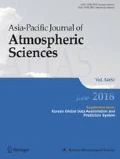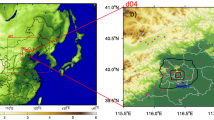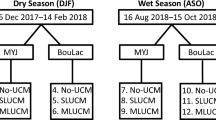Abstract
The vegetated urban canopy model (VUCM) is implemented in a meteorological model, the Regional Atmospheric Modeling System (RAMS), for urban atmospheric modeling. The VUCM includes various urban physical processes such as in-canyon radiative transfer, turbulent energy exchanges, substrate heat conduction, and in-canyon momentum drag. The coupled model RAMS/VUCM is evaluated and then used to examine its impacts on the dynamic and thermodynamic structure of the urban boundary layer (UBL) in the Seoul metropolitan area. The spatial pattern of the nocturnal urban heat island (UHI) in Seoul is quite well simulated by the RAMS/VUCM. A statistical evaluation of 2-m air temperature reveals a significant improvement in model performance, especially in the nighttime. The RAMS/VUCM simulates the diurnal variations of surface energy balance fluxes realistically. This contributes to a reasonable UBL formation. A weakly unstable UBL is formed in the nighttime with UBL heights of about 100–200 m. When urban surfaces are represented in the RAMS using a land surface model of the Land Ecosystem-Atmosphere Feedback (LEAF), the RAMS/LEAF produces strong cold biases and thus fails to simulate UHI formation. This is due to the poor representation or absence of important urban physical processes in the RAMS/LEAF. This study implies that urban physical processes should be included in numerical models in order to reasonably simulate meteorology and air quality in urban areas and that the VUCM is one of the promising urban canopy models.
Similar content being viewed by others
References
Allwine, K. J., J. H. Shinn, G. E. Streit, K. L. Clawson, and M. Brown, 2002: Overview of URBAN 2000: A multiscale field study of dispersion through an urban environment. Bull. Amer. Meteor. Soc., 83, 521–536.
Asaeda, T., V. T. Ca, and A. Wake, 1996: Heat storage of pavement and its effect on the lower atmosphere. Atmos. Environ., 30, 413–427.
Avissar, R., and R. A. Pielke, 1989: A parameterization of heterogeneous land surfaces for atmospheric numerical models and its impact on regional meteorology. Mon. Wea. Rev., 117, 2113–2136.
Best, M. J., C. S. B. Grimmond, and M. G. Villani, 2006: Evaluation of the urban tile in MOSES using surface energy balance observations. Bound.-Layer Meteor., 118, 503–525.
Chen, C., and W. R. Cotton, 1983: A one-dimensional simulation of the stratocumulus-capped mixed layer. Bound.-Layer Meteor., 25, 289–321.
Davies, H. C., 1976: A lateral boundary formulation for multi-level prediction models. Quart. J. Roy. Meteor. Soc., 102, 405–418.
Deardorff, J. W., 1978: Efficient prediction of ground surface temperature and moisture, with inclusion of a layer of vegetation. J. Geophys. Res., 83(C4), 1889–1903.
Dickinson, R. E., M. Shaikh, R. Bryant, and L. Graumlich, 1998: Interactive canopies for a climate model. J. Climate, 11, 2823–2836.
Dupont, E., L. Menut, B. Carissimo, J. Pelon, and P. Flamant, 1999: Comparison between the atmospheric boundary layer in Paris and its rural suburbs during the ECLAP experiment. Atmos. Environ., 33, 979–994.
Feigenwinter, C., R. Vogt, and E. Parlow, 1999: Vertical structure of selected turbulence characteristics above an urban canopy. Theor. Appl. Climatol., 62, 51–63.
Garratt, J. R., 1992: The atmospheric boundary layer. Cambridge University Press., 316 pp.
Grimmond, C. S. B., 2007: Urbanization and global environmental change: Local effects of urban warming. Geogr. J., 173, 83–88.
____, and T. R. Oke, 2002: Turbulent heat fluxes in urban areas: Observations and a local-scale urban meteorological parameterization scheme (LUMPS). J. Appl. Meteor., 41, 792–810.
Helfand, H. M., and J. C. Labraga, 1988: Design of a nonsingular level 2.5 second-order closure model for the prediction of atmospheric turbulence. J. Atmos. Sci., 45, 113–132.
Holt, T., and J. Pullen, 2007: Urban canopy modeling of the New York city metropolitan area: A comparison and validation of single- and multilayer parameterization. Mon. Wea. Rev., 135, 1906–1930.
Jiang, H., and W. R. Cotton, 2000: Large eddy simulation of shallow cumulus convection during BOMEX: Sensitivity to microphysics and radiation. J. Atmos. Sci., 57, 582–594.
Kastner-Klein, P., E. Fedorovich, and M. W. Rotach, 2001: A wind tunnel study of organised and turbulent air motions in urban street canyons. J. Wind Eng. Ind. Aerodyn., 89, 849–861.
Kim, Y.-H., and J.-J. Baik, 2002: Maximum urban heat island intensity in Seoul. J. Appl. Meteor., 41, 651–659.
Kusaka, H., H. Kondo, Y. Kikegawa, and F. Kimura, 2001: A simple single-layer urban canopy model for atmospheric models: Comparison with multi-layer and slab models. Bound.-Layer Meteor., 101, 329–358.
Lee, H. W., H.-J. Choi, S.-H. Lee, Y.-K. Kim, and W.-S. Jung, 2008: The impact of topography and urban building parameterization on the photochemical ozone concentration of Seoul, Korea. Atmos. Environ., 42, 4232–4246.
Lee, S.-H., and S.-U. Park, 2008: A vegetated urban canopy model for meteorological and environmental modelling. Bound.-Layer Meteor., 126, 73–102.
_____, and J.-J. Baik, 2010: Statistical and dynamical characteristics of the urban heat island intensity in Seoul. Theor. Appl. Climatol., 100, 227–237.
_____, C.-K. Song, J.-J. Baik, and S.-U. Park, 2009: Estimation of anthropogenic heat emission in the Gyeong-In region of Korea. Theor. Appl. Climatol., 96, 291–303.
Lee, T. J., and R. A. Pielke, 1992: Estimating the soil surface specific humidity. J. Appl. Meteor., 31, 480–484.
Lemonsu, A., C. S. B. Grimmond, and V. Masson, 2004: Modeling the surface energy balance of the core of an old Mediterranean city: Marseille. J. Appl. Meteor., 43, 312–327.
Lyons, W. A., R. A. Pielke, C. J. Tremback, R. L. Walko, D. A. Moon, and C. S. Keen, 1995: Modeling impacts of mesoscale vertical motions upon coastal zone air pollution dispersion. Atmos. Environ., 29, 283–301.
Martilli, A., A. Clappier, and M. W. Rotach, 2002: An urban surface exchange parameterisation for mesoscale models. Bound.-Layer Meteor., 104, 261–304.
Masson, V., 2000: A physically-based scheme for the urban energy budget in atmospheric models. Bound.-Layer Meteor., 94, 357–397.
McQueen, J. T., R. A. Valigura, and B. J. B. Stunder, 1997: Evaluation of the RAMS model for estimating turbulent fluxes over the Chesapeake Bay. Atmos. Environ., 31, 3803–3819.
Mestayer, P. G., and Coauthors, 2005: The urban boundary-layer field campaign in Marseille (UBL/CLU-ESCOMPTE): Set-up and first results. Bound.-Layer Meteor., 114, 315–365.
Nunez, M., and T. R. Oke, 1976: Long-wave radiative flux divergence and nocturnal cooling of the urban atmosphere. Bound.-Layer Meteor., 10, 121–135.
Oke, T. R., R. A. Spronken-Smith, E. Jauregui, and C. S. B. Grimmond, 1999: The energy balance of central Mexico City during the dry season. Atmos. Environ., 33, 3919–3933.
Oleson, K. W., G. B. Bonan, J. Feddema, M. Vertenstein, and C. S. B. Grimmond, 2008: An urban parameterization for a global climate model. Part I: Formulation and evaluation for two cities. J. Appl. Meteor. Climatol., 47, 1038–1060.
Pielke, R. A., and Coauthors, 1992: A comprehensive meteorological modeling system-RAMS. Meteor. Atmos. Phys., 49, 69–91.
Sellers, P. J., D. A. Randall, G. J. Collatz, J. A. Berry, C. B. Field, D. A. Dazlich, C. Zhang, G. D. Collelo, and L. Bounoua, 1996: A revised land surface parameterization (SiB2) for atmospheric GCMs. Part I: Model formulation. J. Climate, 9, 676–705.
Tremback, C. J., 1990: Numerical simulation of a mesoscale convective complex: Model development and numerical results. Ph.D. dissertation, Colorado State University, 247 pp.
United Nations, 2004: World urbanization prospects: The 2003 revision. United Nations Department of Economic and Social Affairs, 34 pp. [Available online at http://www.un.org/esa/population/publications/wup2003/2003Highlights.pdf.]
Walko, R. L., and Coauthors, 2000: Coupled atmosphere-biophysicshydrology models for environmental modeling. J. Appl. Meteor., 39, 931–944.
Willmott, C. J., 1981: On the validation of models. Phys. Geogr., 2, 184–194.
Zhong, S., and J. Fast, 2003: An evaluation of the MM5, RAMS and Meso-Eta models at subkilometer resolution using VTMX field campaign data in the Salt Lake valley. Mon. Wea. Rev., 131, 1301–1322.
Author information
Authors and Affiliations
Corresponding author
Rights and permissions
About this article
Cite this article
Lee, SH., Baik, JJ. Evaluation of the vegetated urban canopy model (VUCM) and its impacts on urban boundary layer simulation. Asia-Pacific J Atmos Sci 47, 151–165 (2011). https://doi.org/10.1007/s13143-011-0005-z
Received:
Revised:
Accepted:
Published:
Issue Date:
DOI: https://doi.org/10.1007/s13143-011-0005-z




